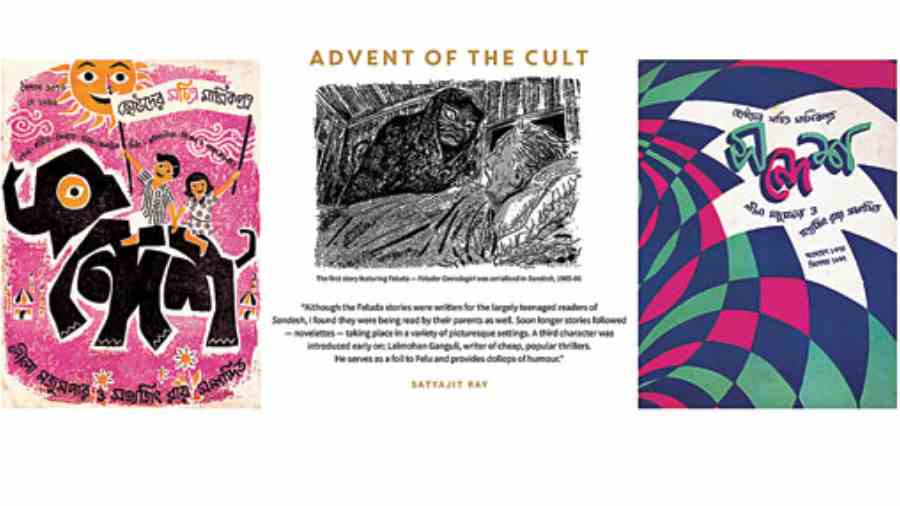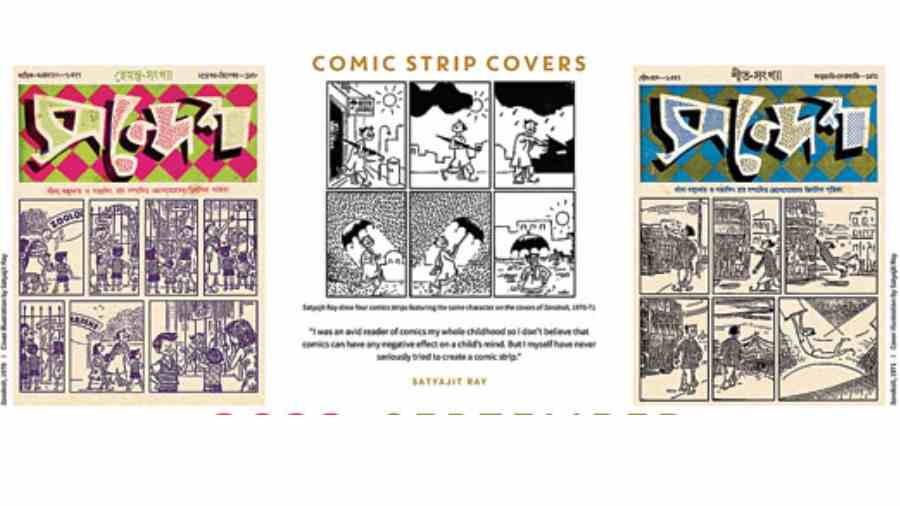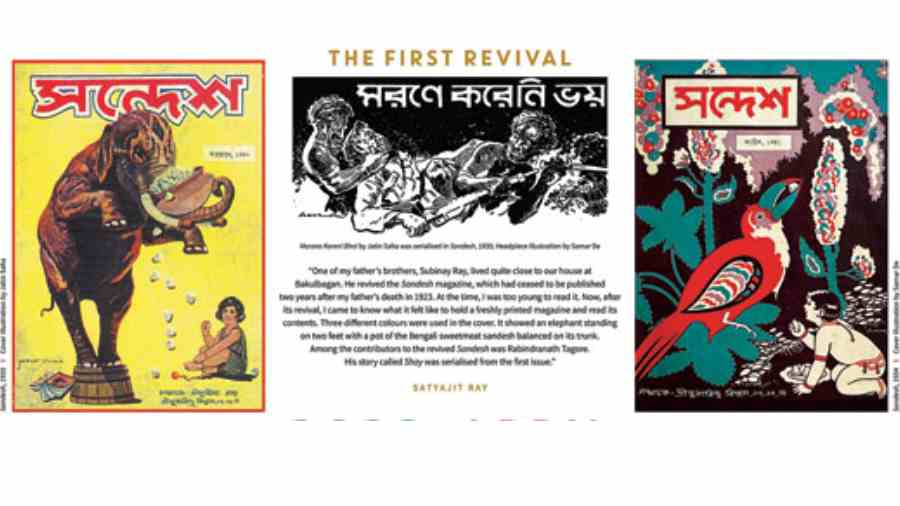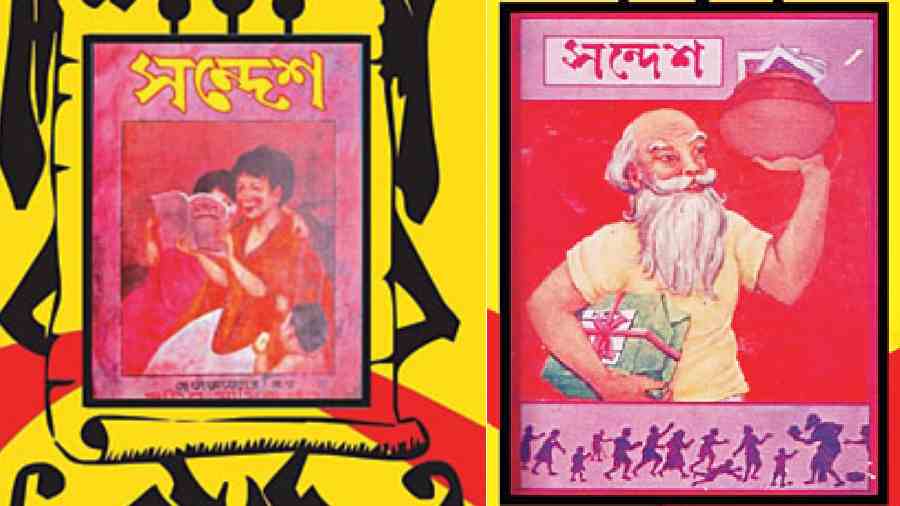The covers of a magazine that have captivated readers across four generations of illustrators are the subject of two calendars this year.
The 110th anniversary of Sandesh was marked by the release of the calendars by Sandip Ray, the fourth generation of the family and the current editor. One was launched at the ICCR café while the other launch took place at the Starmark store in South City Mall within a week of each other.
“Upendrakisor Raychaudhuri had three dreams — sending his three sons abroad for studies, founding a children’s magazine and building a house designed by himself (at 100A Garpar Road where both Sandesh and grandson Satyajit Ray were born, in 1913 and 1921 respectively). He invested almost everything he had in Sandesh. Despite World War I breaking out within a year of the launch and cost of paper skyrocketing, he did not raise the magazine’s price. When his son Sukumar Ray became the editor in 1915, he changed the target readership from children to adolescents. But he too died soon after, in 1923. Then his brother Subinoy took over but he could not keep the magazine running for long,” said researcher and collector Debasis Mukhopadhyay, who has copies of the first seven years of Sandesh almost in entirety.
One reason why accessing the old Sandesh covers is a challenge is the practice of binding volumes of magazines without the covers and advertisements. “Upendrakisor printed all the advertisements together at the start or the end of the volume, so those pages were simply torn off by the binders,” Mukhopadhyay said.
The advertisements carried in Sandesh, he said, were mostly of magazines, toys and medicines. “One ad is on an album of 25 photographs of Rabindranath Tagore published by U Ray & Sons. The photographer must have been Sukumar, a fellow of the Royal Photographic Society,” he reasoned.
Sukumar had gifted the first copy of Sandesh to Tagore in England, seeking his contribution. Tagore kept his word later. Kazi Nazrul Islam too wrote for Sandesh in this phase. “He also introduced articles on science. He used the word akashbani in his article on radio titled Akashbanir Kol, in 1921,” said Prasadranjan Ray, president of Ray Society and a member of the magazine’s editorial board.
Sandesh shut down once in 1925, and then after a brief revival in 1929, again in 1934.

An illustration from the first story featuring Feluda,Feludar Goendagiri,which was serialised in Sandesh in 1965-66.From the Starmark calendar
Ray takes over
Sandesh was revived in 1961 by Satyajit, at the inspiration of his mother Suprava Debi. That year, Professor Shonku appeared in Byomjatrir Diary. The Starmark calendar, which has Satyajit’s comments on each subject featured, quotes him saying that Shonku “may be said to be a mild-mannered version of (Sir Arthur Conan Doyle’s) Professor Challenger...”
Archivist Debajit Bandyopadhyay recalled Satyajit’s innovation of cartoons on four covers. “I remember one in which a man who runs to catch a bus and hangs on to its handle ends up with elongated hands and becomes a trapeze artiste in a circus,” he recalled.
Satyajit illustrated two magazines through his life — Sandesh and Ekkhan. Bandyopadhyay picked Samaddarer Chabi as the story with the best Ray illustrations.
“We have covered the journey of Sandesh from Upendrakisor to Sandip Ray. The best of authors have written here. Feluda and Shonku were born in these pages,” said Sudipto Chanda, whose company The Dreamers has published the wall calendar.
Sandesh covers had been illustrated by other artistes too, like Jatin Saha, Samar Dey and Debabrata Ghosh, but the wall calendar focuses only on the Ray family. The Starmark one makes space for the designers outside the family too.

Sandesh covers from 1970-71 when Satyajit Ray used to create four panel comic strips. From the Starmark calendar

Sandesh covers by illustrators outside the Ray family — by Jatin Saha (left) and Samar De. From the Starmark calendar

(Left) The first issue of Sandesh illustrated by Upendrakisor Raychaudhuri. (Right) A cover illustrated by Sukumar Ray. From The Dreamers calendar
Page by page
The first page of the wall calendar features two Sandesh covers — of the first issue illustrated by Upendrakisor, and another by Sukumar. “In the editor’s note in the first issue, Upendrakisor points out that sandesh, though commonly indicating the sweetmeat, originally meant good news. And like the sweetmeat, the magazine would please (with good news) as well as provide (mental) nourishment. Both he and Sukumar incorporated sweets and the magazine in their cover ideas. But once Satyajit started illustrating the cover, he introduced animals through calligraphed lettering.
“Whichever film he was working on often influenced his illustration. Thus there was a bhoot on the Sandesh cover during Goopi Gyne Bagha Byne and an elephant during Hirak Rajar Deshe,” Mukhopadhyay told The Telegraph.
The last page of the wall calendar has covers illustrated by Sandip. “We could bring out only two issues of Sandesh in 2020. In 2021-22, there were five or six. The latest is the December edition that came out this January. Our target now is to regularise the publication to every alternate month,” he said.
The desk calendar features a striking Satyajit Ray illustration for his first story in which Feluda appears, Feludar Goendagiri, in 1965-66. Pinaki De, the designer of the Starmark calendar, points out that the illustration (of a masked man at an old man’s bedside) was chosen as it is technically an exciting piece of work, combining a method he must have learnt in advertising with his own sketching skill. “The half-tone texture is the result of Letraset dry transfer. He drew the outlines and created the shadow with brush but transferred the texture through this technique that was in vogue in advertising,” said Pinaki.
This is the fifth calendar brought out by Starmark on Ray. “We have been associated with the Ray Society for many years and we publish these special calendars in collaboration with them, which have become collectors’ items,” said Gautam Jatia, MD and CEO of Starmark, Emami Frank Ross.
Sandip and publisher Amitananda Das, the son of former Sandesh joint editor and Sukumar’s niece Nalini Das, shared that they were mulling an online version of the print edition of Sandesh. “That way we can reach out to readers across India, and later through the world,” Das said.
